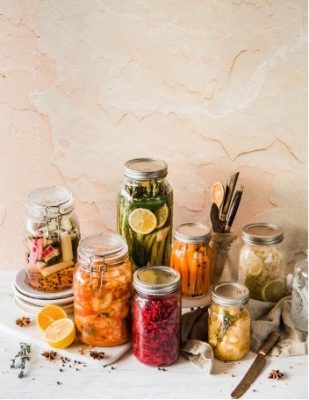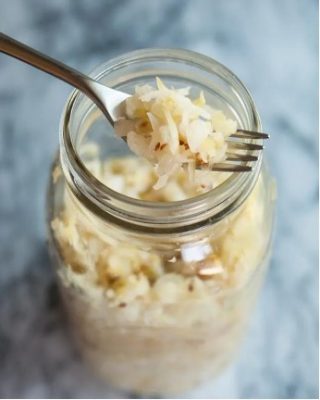Written by UConn Dietetics Student Amy Corcoran
Fermented foods and drinks have been around for thousands of years, and they’re making a comeback! Fermentation is a process where microorganisms (think yeast, bacteria, and mold) break down the sugars in food to release acids, gases, nutrients, and alcohols. It’s how milk turns to tangy yogurt, cabbage turns to sauerkraut, and even how grapes turn to wine!
Fermented foods include:

- Yogurt
- Traditional dill pickles
- Sourdough bread
- Kimchi, Korean pickled vegetables
- Sauerkraut, fermented cabbage that, although a German word, traces back to China
- Tempeh, Indonesian fermented soybean cakes
- Miso, a salty soybean paste fermented with mold
- Kefir, a fermented milk drink
- Kombucha, fermented tea from China
- Natto, a sticky, stringy fermented soybean dish from Japan
- Fermented fish, a Swedish dish
- Vinegar
- Injera, a fermented Ethiopian pancake
- Olives, so many varieties!
Fermentation traces back to early civilization and is found in the traditional foods of many cultures. It allowed our ancestors to store foods and drinks without refrigeration, to explore new flavors, and to reduce toxins.
Today, we are discovering the many health benefits of fermentation. Fermentation can make foods easier to digest and even help our gut make certain vitamins, such as B vitamins, which help give us energy. Fermented foods and drinks also contain probiotics, which are the “good bacteria” that keep your gut healthy and in balance.
Fermented foods are associated with reduced risk of heart disease, diabetes, obesity, inflammation, and high blood pressure. They are also linked with improving moods, bone health, weight, and recovery after exercise!2,3
If you like unique, tangy flavors, both sour and savory, there are many ways to add fermented foods and drinks into your diet. Have yogurt with breakfast or as a snack (if you’re feeling adventurous, try kefir, which is like a drinkable yogurt), add sauerkraut to a sandwich (it pairs well with grilled cheese, egg salad, and tuna salad), top a salad with pickled vegetables, or add tempeh to a stir-fry. To cut back on salt, rinse the pickled vegetables (the flavor won’t be affected!), check labels for low-sodium options (<140 mg/serving), or try fermented foods lower in salt, such as yogurt or kefir.
Making fermented food at home is fun, affordable, and a creative way to add more vegetables to your diet! Try out this recipe for homemade sauerkraut – all you need are two ingredients!
Homemade Sauerkraut
Ingredients
- 1 medium sized cabbage
- 1 1/2 tablespoons kosher salt
- Spices (optional, to taste): try dill, caraway seeds, or celery seeds!
Directions

- Wash your hands and all supplies
- Slice the cabbage into thin pieces, removing the core
- In a big bowl, massage the cabbage with the salt and spices for 5-10 minutes, or until the water from the cabbage is released
- Transfer the cabbage and all juices into two, 1 quart mason jars
- Pack down the cabbage by placing a jelly jar filled with weights (try marbles!) inside the mason jar
- Cover the jars with a cloth and secure with a rubber band
- Every couple of hours, press down the cabbage using the jelly jar to release more juices *if after 24 hours the cabbage is not submerged, dissolve 1 tsp of salt in 1 cup of water and add until the cabbage is covered
- Store for 3-10 days out of direct sunlight between 65˚F and 75˚F
- Remove the jelly jar, cap the mason jar, and refrigerate the sauerkraut (it will keep for at least two months)
Recipe link: https://www.thekitchn.com/how-to-make-homemade-sauerkraut-in-a-mason-jar-193124
Citations
- Clime, K. Beyond sauerkraut: A brief history of fermented foods. Message posted to https://www.lhf.org/2014/03/beyond-sauerkraut-a-brief-history-of-fermented-foods/
- Şanlier, N., Gökcen, B. B., & Sezgin, A. C. (2019). Health benefits of fermented foods. Critical reviews in food science and nutrition, 59(3), 506–527. https://doi.org/10.1080/10408398.2017.1383355
- Marco, M. L., Heeney, D., Binda, S., Cifelli, C. J., Cotter, P. D., Foligné, B., Gänzle, M., Kort, R., Pasin, G., Pihlanto, A., Smid, E. J., & Hutkins, R. (2017). Health benefits of fermented foods: microbiota and beyond. Current opinion in biotechnology, 44, 94–102. https://doi.org/10.1016/j.copbio.2016.11.010
- Fermented foods: The latest trend. (2018). https://www.heartfoundation.org.nz/about-us/news/blogs/fermented-foods-the-latest-trend
- Harvard Health Publishing. (2018). Fermented foods can add depth to your diet.https://www.health.harvard.edu/staying-healthy/fermented-foods-can-add-depth-to-your-diet
- Ray, R., & Joshi, V. (2014). Fermented foods: Past, present and future.
This material is funded by USDA’s Supplemental Nutrition Assistance Program (SNAP).
This institution is an equal opportunity employer